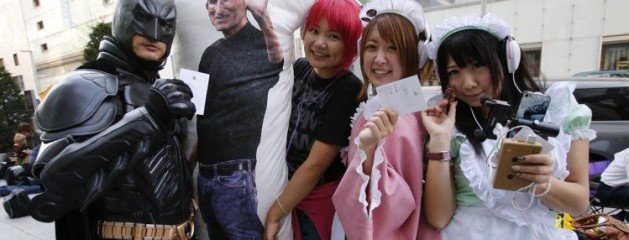Apple acolytes got their hands on new iPhones Friday in the global roll-out of two new models, but failure to make headway in China and complaints about the price struck a sour note.
The once-unbeatable king of the smartphones has penned a potentially lucrative new deal with Docomo, Japan’s biggest mobile carrier, but is without a new alliance in the vast Chinese market.
That, and rumblings over the high cost—even of the pared-down iPhone 5C—could mute the fanfare that routinely accompanies launches, observers say.
In Tokyo, diehard fans began lining up last week, and even sat out a weekend typhoon to keep their spot in a queue that grew to around a kilometer in length by opening time, police estimated.
As well as the usual enthusiastic reception in Japan, where most models sold will be bundled with contracts that will see no big up-front payments, the launch marked a welcome new chapter for Apple.
A fresh deal with Docomo, the mobile unit of NTT, has opened up a much wider cross-section of Japan’s cash-rich, gadget-loving consumers after years in which both companies lost market share.
Docomo is looking to reverse years of watching domestic rivals cash in on the iPhone bonanza.
The firm, which has about 42% of the Japanese market, has shed more than 3.5 million subscribers to rivals since 2008, when SoftBank first rolled out the iPhone in Japan, local media reported.
“Docomo’s partnership should be a favorable wind for Apple in Japan,” said Toshihiko Matsuno, chief strategist at SMBC Friend Securities.
The double debut kicked off in Australia when stores threw open their doors to eager crowds at 8 a.m. Friday.
Jimmy Gunawan, 33, was first in line at the company’s flagship Sydney store, but was surprised he only had to stake his place 20 hours beforehand.
“Last year, I got here around the same time and there was already a queue of about 20 people,” the freelance graphic designer said.
Worldwide, some Apple fans were not prepared either to line up or shell out the asking price.
“Wow, $1,129 (U.S.$1,065) for an iPhone 5s here in Australia. That’s simply insane,” tweeted Bill Hutchison, referring to the cost of a 64GB model of the new version, which boasts a speedier processor and a fingerprint sensor.
Another, David Smith, tweeted: “Incredible—Apple charging $99 for iPhone 5c in the USA (with a contract) but $740 in Australia and its $1,200 for 5s – no wonder Android phones are popular.”
The polycarbonate-bodied 5c, supposedly aimed at budget-conscious smartphone shoppers, was widely trailed as Apple’s answer to the onslaught of cheaper, Android-powered models, led by Samsung.
But its hefty $700 ticket price in China will put it out of reach of most consumers in the world’s biggest mobile market.
“It’s not worth the price,” said Wang Ying, a Beijing-based analyst with consultant firm iResearch. Many domestically made smartphones are priced as low as $100.
Apple has not revealed what the “c” stands for, but did not knock down months of media speculation that it was intended to signify “cheap” or “China”.
Wang said Apple also appeared to have missed a trick by not reaching a deal with China Mobile and its 700 million subscribers—the country’s largest carrier.
Currently, Apple has sales contracts with China Unicom and China Telecom.
“Apple’s performance is declining in the world as well as in China,” Wang said. “Cooperating with China Mobile will be a significant channel for Apple to… win more users.”





